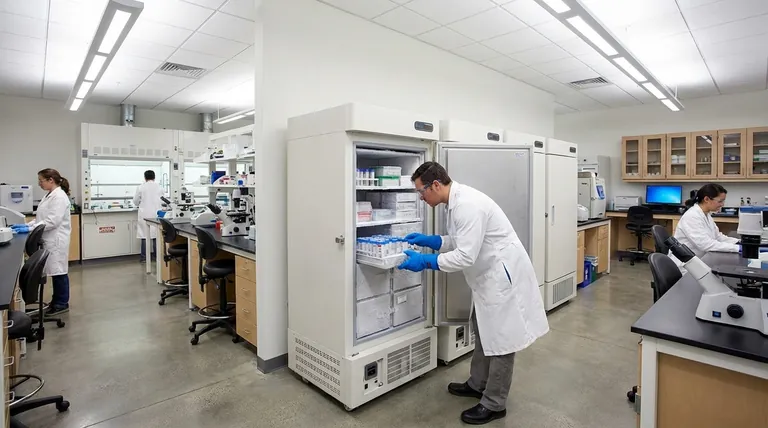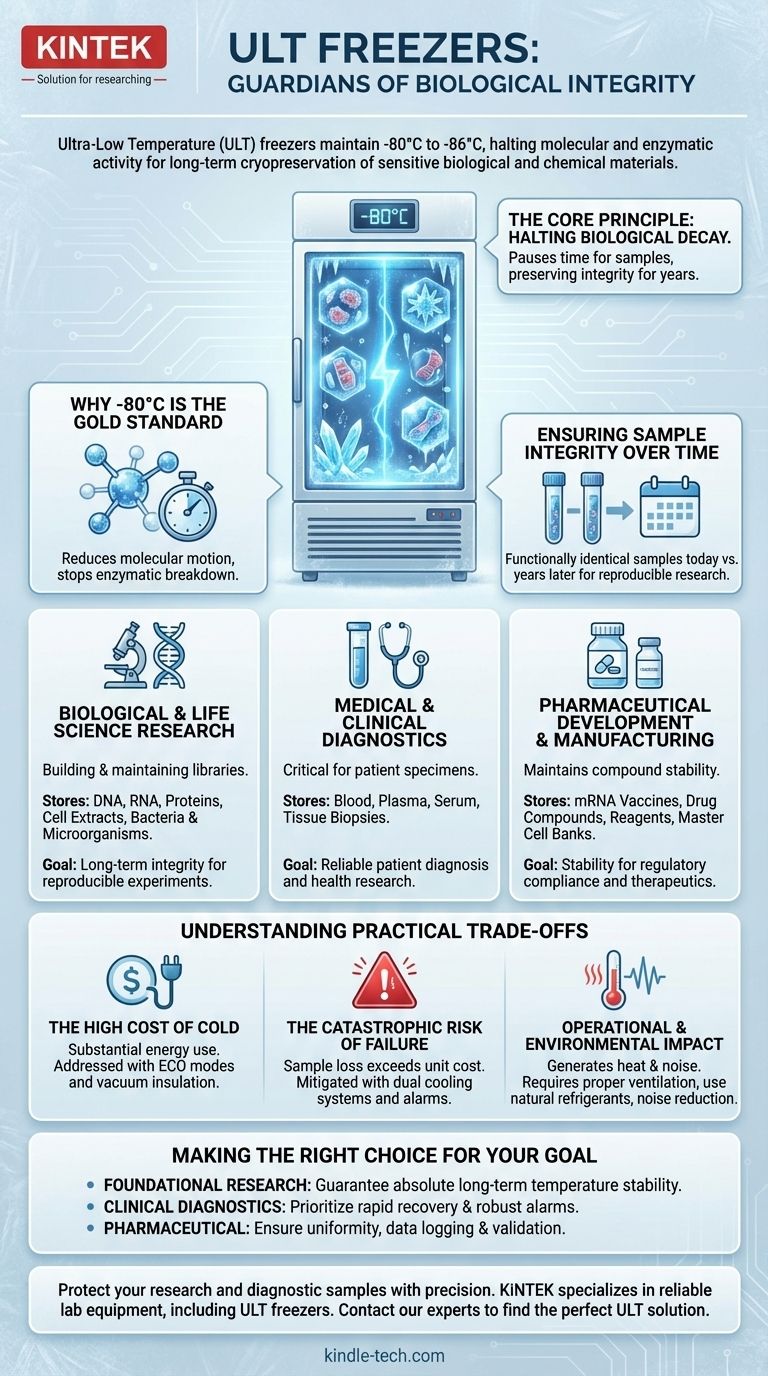In short, Ultra-Low Temperature (ULT) freezers are primarily used for the long-term cryopreservation of sensitive biological and chemical materials. These specialized units maintain temperatures between -80°C and -86°C, effectively halting molecular and enzymatic activity to prevent the degradation of invaluable samples such as DNA, RNA, proteins, vaccines, and tissue samples.
The core problem is that biological samples are inherently unstable and begin to degrade almost immediately at room or even standard refrigeration temperatures. A ULT freezer solves this by creating an environment so cold that it essentially pauses time for these samples, preserving their integrity for years or even decades.

The Core Principle: Halting Biological Decay
To understand the application of ULT freezers, you must first understand the fundamental problem they solve. At their core, they are instruments designed to stop the clock on biological and chemical processes.
Why -80°C is the Gold Standard
At standard temperatures, enzymes actively break down molecules, and delicate structures like RNA can degrade in minutes. By lowering the temperature to the ultra-low range of -80°C, the molecular motion required for these reactions is dramatically reduced.
This deep freeze effectively stops all enzymatic activity and chemical degradation, preserving the exact state of the sample at the moment it was frozen.
Ensuring Sample Integrity Over Time
For scientific research and medical diagnostics, reproducibility is everything. A degraded sample can lead to inaccurate results, failed experiments, and flawed conclusions, wasting significant time and resources.
ULT freezers ensure that a sample analyzed today is functionally identical to one that was stored five years ago, providing the long-term stability required for longitudinal studies and reliable data.
Key Application Areas in Modern Laboratories
While the principle is simple, the applications span across numerous scientific and medical fields. A ULT freezer is a cornerstone piece of equipment in any facility handling high-value biologicals.
Biological and Life Science Research
This is the most common application. Academic and corporate research labs rely on ULT freezers to build and maintain libraries of biological materials.
This includes storing DNA and RNA for genetic sequencing, proteins and enzymes for functional analysis, cell extracts for biochemical assays, and cultures of bacteria and microorganisms for future study.
Medical and Clinical Diagnostics
In hospitals and clinical laboratories, ULT freezers are critical for storing patient specimens. These include blood, plasma, serum, and tissue biopsies.
These samples are essential for disease diagnosis, tracking patient progress, conducting genetic testing, and supporting large-scale public health research initiatives.
Pharmaceutical Development and Manufacturing
The pharmaceutical industry depends on ULT freezers to maintain the stability of highly sensitive compounds. This became globally recognized with the storage requirements for mRNA vaccines like the COVID-19 vaccine.
They are also used to store valuable drug compounds, reagents, and master cell banks that form the basis of life-saving therapeutics.
Understanding the Practical Trade-offs
While indispensable, operating a ULT freezer involves significant considerations. It is not a "set it and forget it" appliance.
The High Cost of Cold
Maintaining temperatures of -86°C requires a substantial amount of energy. These units can significantly impact a laboratory's electricity budget.
Modern freezers address this with energy-saving ECO modes, advanced vacuum insulation panels, and more efficient cooling mechanisms to reduce operational costs.
The Catastrophic Risk of Failure
The value of the samples stored within a ULT freezer often far exceeds the cost of the unit itself. A mechanical failure can result in the irreversible loss of years of work or priceless patient samples.
To mitigate this, high-end models feature dual cooling systems, where a secondary system can take over if the primary one fails, along with sophisticated temperature monitoring and alarm systems.
Operational and Environmental Impact
ULT freezers generate considerable heat and noise, which must be accounted for in lab design and workflow.
Proper ventilation is crucial, and manufacturers are increasingly focused on using natural refrigerants and noise-reduction technology to create a safer and more pleasant work environment.
Making the Right Choice for Your Goal
Selecting a ULT freezer depends entirely on the materials you need to protect and the goals of your work.
- If your primary focus is foundational research: You need a freezer that guarantees absolute temperature stability for long-term storage of irreplaceable DNA, cell lines, and protein samples.
- If your primary focus is clinical diagnostics: Prioritize models with rapid temperature recovery after door openings and robust alarm systems to protect a high throughput of valuable patient samples.
- If your primary focus is pharmaceutical manufacturing: Look for units with stringent temperature uniformity, data logging, and validation capabilities to meet strict regulatory compliance standards.
Ultimately, a ULT freezer is not just an appliance; it is the cornerstone of reproducible science and the guardian of future discoveries.
Summary Table:
| Application Area | Key Stored Materials | Primary Goal |
|---|---|---|
| Biological & Life Science Research | DNA, RNA, Proteins, Cell Cultures | Long-term integrity for reproducible experiments |
| Medical & Clinical Diagnostics | Blood, Plasma, Tissue Biopsies | Reliable patient diagnosis and health research |
| Pharmaceutical Development | mRNA Vaccines, Drug Compounds, Reagents | Stability for regulatory compliance and therapeutics |
Protect your research and diagnostic samples with precision. KINTEK specializes in providing reliable lab equipment, including ULT freezers, to meet the demanding cryopreservation needs of research, clinical, and pharmaceutical laboratories. Ensure your valuable biological materials are stored with unwavering stability. Contact our experts today to find the perfect ULT solution for your lab's critical applications.
Visual Guide

Related Products
- 508L Advanced Vertical Ultra Low Temperature Freezer for Critical Laboratory Storage
- 408L Advanced Vertical Laboratory Ultra Low Temperature Freezer for Critical Research Material Preservation
- 58L Precision Laboratory Ultra Low Temperature Upright Freezer for Critical Sample Storage
- 158L Precision Vertical Ultra Low Freezer for Laboratory Applications
- 808L Precision Laboratory Vertical Ultra Low Temperature Freezer
People Also Ask
- How do Ultra-Low Temperature freezers ensure the integrity of microbiological samples? Maintain Stability for Critical Research
- Where are ultra low temperature freezers commonly used? Essential for Labs, Hospitals, and Biotech
- What advantages do ultra-low temperature freezers offer? Ensure Long-Term Sample Integrity and Reliability
- What makes Ultra-Low Temperature freezers energy efficient? Key Design & Operational Strategies
- What temperature range do Ultra-Low Temperature freezers maintain? The -80°C Standard for Sample Integrity



















